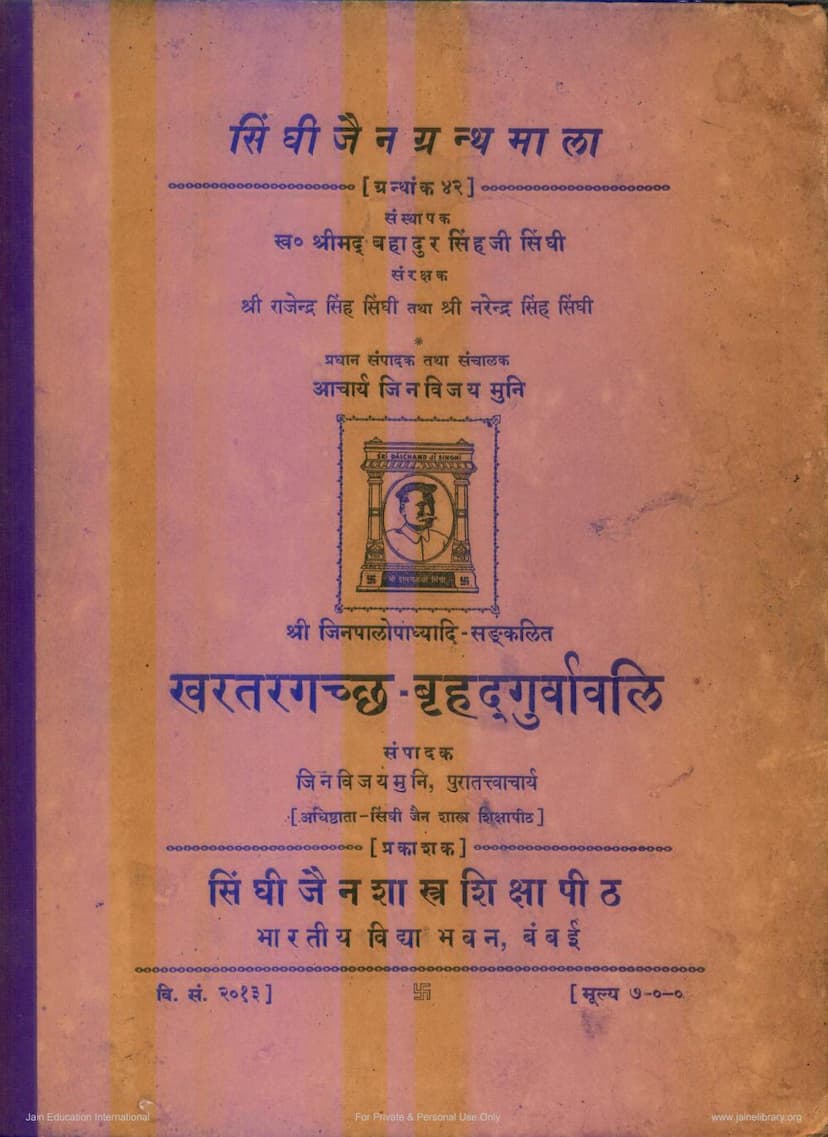Khartar Gacchha Bruhad Gurvavali
Added to library: September 2, 2025

Summary
Here's a comprehensive summary of the Jain text "Khartar Gaccha Bruhad Guravali," based on the provided pages:
Title: Kharatara Gaccha Brihad Guravali (खरतरगच्छ बृहद्गुर्वावलि) Compiler/Editor: Jinapala Upadhyaya and others, compiled and edited by Acharya Jinavijaya Muni. Publisher: Singhi Jain Shastra Shiksha Pith, Mumbai (as part of the Singhi Jain Series, Number 42). Date of Publication: Vikram Samvat 2012 / 1956 A.D.
Overview:
The "Khartara Gaccha Brihad Guravali" is a significant Jain text compiled and edited from various old manuscripts. It serves as a detailed chronicle of the spiritual lineage and the lives of the eminent Ācāryas (spiritual leaders) of the Kharatara Gaccha, a prominent sect within Jainism. The text primarily focuses on the biographical accounts of these Ācāryas, providing historical, philosophical, literary, and narrative insights into their lives, teachings, and contributions.
Key Features and Content:
- Spiritual Lineage: The primary purpose of the Guravali (a text detailing the lineage of spiritual gurus) is to document the succession of Ācāryas within the Kharatara Gaccha. It traces this lineage from the early Ācāryas like Vardhamānācārya up to later figures like Jinapadmasūri.
- Detailed Biographies: The text offers extensive biographical details for each Ācārya. These include:
- Birth and Death Dates: Where available, approximate dates of their lives are mentioned.
- Miracles and Teachings: Accounts of their spiritual powers, the propagation of Jain principles, and significant teachings are highlighted.
- Travels and Vihār (Pilgrimages): The text often describes their extensive travels across various regions of India, including Gujarat, Mewar, Marwar, Sindh, and Punjab, detailing their journeys and the places where they stayed.
- Disciples and Followers: Information about their disciples, their initiation, and their own eventual achievements as spiritual leaders is often included.
- Debates and Discussions (Shastrarth): The Guravali frequently recounts theological debates and intellectual discussions with scholars from other sects or philosophical schools, often emphasizing the victory of the Kharatara Gaccha Ācāryas.
- Patronage and Royal Interactions: The text details interactions with various kings, rulers, and prominent patrons, including their conversion, financial support for Jain institutions, and respect shown to the Ācāryas. Notable kings mentioned include Durlabhraj of Gujarat, Narvarma of Dharanagari, Arnoraja of Ajmer, Kumarpala of Tribhuvanagiri, Madanpal of Delhi, Bhimasingh of Ashika, and Prithviraj Chauhan of Ajmer.
- Social and Cultural Context: The Guravali provides a glimpse into the social and cultural life of the time, mentioning the names of numerous affluent and devout Śrāvakas (lay followers) and Śrāvikās (female lay followers) who supported the Gaccha's activities through donations, the establishment of temples, and the organization of religious festivals (Utsavas).
- Literary Works: While primarily biographical, the text implicitly highlights the intellectual prowess and literary contributions of the Ācāryas by mentioning their debates and the propagation of Jain literature.
- Historical Significance: The Guravali is considered a unique and invaluable source for understanding the history of the Kharatara Gaccha and, by extension, Jainism in medieval India. It offers chronological accounts and specific details that help reconstruct the historical trajectory of the sect. The editor, Acharya Jinavijaya Muni, emphasizes its importance for historical research.
- Manuscript Challenges: The editor notes that the original manuscript used for publication was in a very poor condition, with numerous errors. Despite efforts to find other copies, they were unsuccessful. The editing process involved meticulous comparison and correction of the text based on the editor's familiarity with Jain traditions and other similar texts.
- Structure: The book includes an introduction, descriptions of the historical importance of the Guravali, descriptions of individual Ācāryas (e.g., Vardhamānācārya, Jinēśvarasūri, Jinacandrasūri, Abhayadēvasūri, Jinavallabhasūri, JinaDattaSūri, JinapatiSūri, Jineśvarasūri, Jinasiṃhasūri, Jinaprabhasūri, Jinakusalamūri, Jinapadmasūri), a section on "Vriddhācārya Prabandhāvali" (biographies of earlier Ācāryas), and an index of special names.
Key Figures Mentioned (Ācāryas and Patrons):
- Ācāryas: Vardhamānācārya, Jinēśvaramūri, Jinacandrasūri, Abhayadēvasūri, Jinavallabhasūri, Jinadattasūri, JinapatiSūri, Jineśvarasūri, Jinasiṃhasūri, Jinaprabhasūri, Jinakusalamūri, Jinapadmasūri, and others.
- Kings and Rulers: Durlabharāja (Chaulukya), Naravarman (of Dhar), Arnorāja (of Ajmer), Kumarpala, Prithviraj Chauhan, Bhimadeva, Bhimasingh, Arisingha, Sarangadeva, Somasingha, Someshvara Chauhan, Kutubuddin, Gayasuddin, Mahipāladeva, Shikharasingha, Haripāladeva, Rudranandan, Udai Singh, Chachigadeva, Mandalik, Samarasingha, etc.
Singhi Jain Series:
The publication is part of the "Singhi Jain Series," established in memory of Seth Sri Dalchandji Singhi of Calcutta, by his son Sri Bahadur Singh Singhi. The series aims to publish critical editions of important Jain canonical, philosophical, historical, literary, and narrative works in various Prakrit, Sanskrit, Apabhramsa, and Old Rajasthani and Gujarati languages. The series is under the patronage of Shri Rajendra Singh Singhi and Shri Narendra Singh Singhi. Acharya Jinavijaya Muni is the Director and General Editor.
Overall Significance:
The "Khartara Gaccha Brihad Guravali" is an indispensable resource for scholars of Jain history, literature, and culture. It provides primary source material that sheds light on the development of Jain monastic orders, the intellectual and religious life of the medieval period, and the socio-political landscape of ancient India. The detailed narrative style and the inclusion of numerous anecdotes and historical events make it a compelling read for those interested in the rich heritage of Jainism.